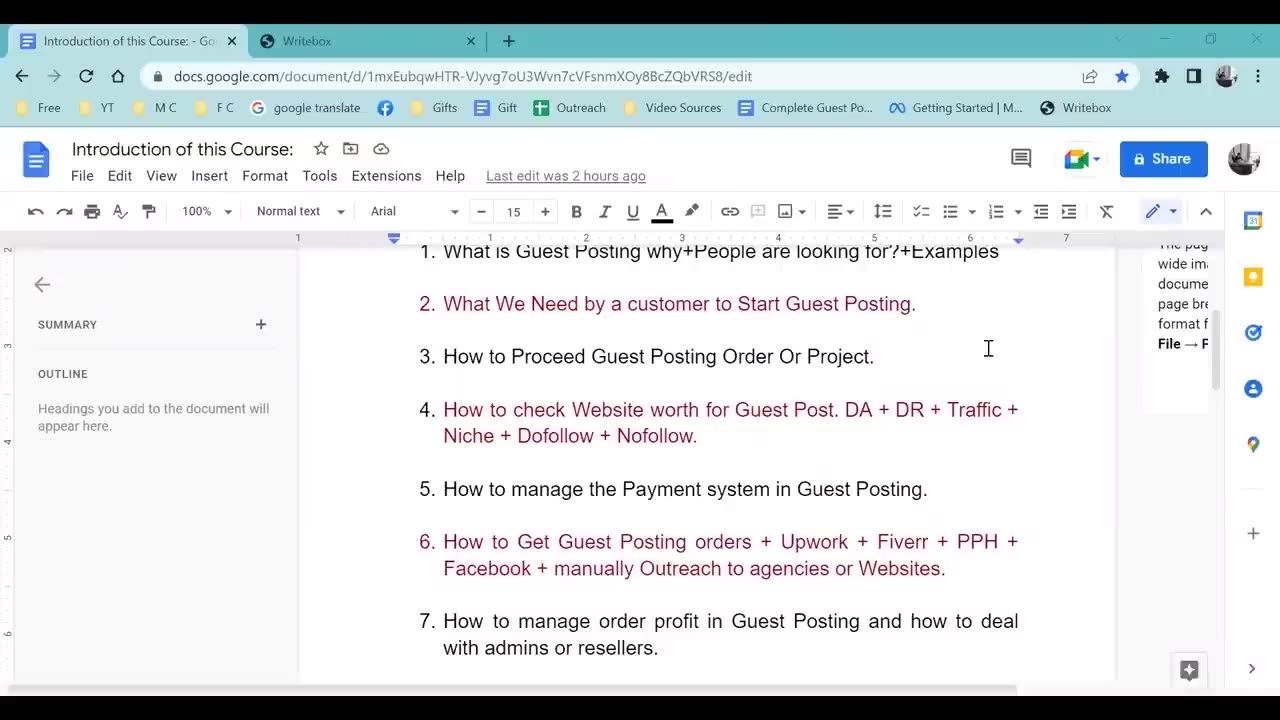Premium Only Content

Guest Post full Course in Urdu Guest Posting Course
Creating a full guest posting course involves a systematic approach to ensure you provide valuable and actionable content to your learners. Here's a step-by-step guide on how to create a guest posting course:
1. Define Course Objectives:
Clearly outline the goals of your course. What should learners achieve after completing the course? Define the skills, knowledge, and outcomes you want to deliver.
2. Identify Target Audience:
Determine who your course is intended for. Are you targeting beginners, intermediate writers, or advanced marketers? Understanding your audience helps tailor your content accordingly.
3. Plan Course Modules:
Divide your course into modules or sections based on different aspects of guest posting. For example:
Introduction to Guest Posting
Finding the Right Guest Posting Opportunities
Crafting Effective Pitches
Writing Compelling Guest Posts
Outreach and Relationship Building
Metrics and Tracking
4. Develop Course Content:
For each module, create content that includes videos, written guides, downloadable resources, quizzes, and assignments. Mix different formats to keep learners engaged.
5. Record Video Lectures:
Record video lectures where you explain concepts, demonstrate processes, and provide insights. Use screen recording software if needed. Keep the videos concise and engaging.
6. Create Written Guides:
Develop detailed written guides, step-by-step instructions, and templates that learners can reference. Make the content actionable and easy to follow.
7. Interactive Elements:
Include interactive elements such as quizzes to reinforce learning and assignments that allow learners to apply what they've learned.
8. Guest Expert Contributions:
Invite guest experts who are experienced in guest posting to provide insights, tips, and real-world examples. This adds credibility and diversity to the course.
9. Choose a Platform:
Select a learning management system (LMS) to host your course. Popular options include Teachable, Thinkific, Udemy, or even creating a dedicated section on your website using plugins.
10. Build the Course:
Organize your content within the chosen platform. Structure the course logically, making it easy for learners to navigate through modules.
11. Create Engagement Opportunities:
Include discussion forums or community spaces where learners can interact, ask questions, and share their progress. This fosters a sense of community and collaboration.
12. Pricing and Monetization:
Decide whether to offer the course for free, charge a one-time fee, or implement a subscription model. Set up payment gateways if you're monetizing the course.
13. Marketing and Promotion:
Promote your course through various channels such as social media, email newsletters, blog posts, and relevant online communities. Highlight the value learners will gain.
14. Launch and Support:
Launch your course and provide support to enrolled learners. Address their questions, concerns, and provide guidance as needed.
15. Gather Feedback and Iterate:
After the course has run for a while, gather feedback from learners. Use this feedback to improve the course, enhance content, and address any issues.
16. Continuous Updates:
Guest posting practices and platforms can change over time. Regularly update the course to reflect the latest trends and best practices.
Creating a successful guest posting course takes dedication, expertise, and continuous improvement. Focus on delivering value to your learners and helping them achieve their guest posting goals.
-
 LIVE
LIVE
Steven Crowder
2 hours ago🔴 Jay Dyer on Hollywood, The Occult, and the Attack on the American Soul
21,929 watching -
 29:07
29:07
The Rubin Report
2 hours agoAre Megyn Kelly & Erika Kirk Right About Our Political Divisions?
8.34K10 -
 27:09
27:09
VINCE
2 hours agoSaving America's Schools with Norton Rainey | Episode 177 - 11/26/25 VINCE
95.8K59 -
 LIVE
LIVE
Benny Johnson
2 hours agoFBI Director Kash Patel Makes January 6th Pipe Bomber Announcement: Massive Breakthrough, Stay Tuned
5,738 watching -
 1:06:17
1:06:17
Graham Allen
3 hours agoFAKE NEWS Is Everywhere!! Are We Living In The Upside Down?!
115K421 -
 LIVE
LIVE
Wendy Bell Radio
6 hours agoFeeding Their Greed
6,334 watching -

Badlands Media
9 hours agoBadlands Daily: November 26, 2025
31.9K4 -
 1:13:11
1:13:11
Chad Prather
18 hours agoGratitude That Grows in Hard Ground: A Thanksgiving Message for the Soul
68.4K40 -
 LIVE
LIVE
LFA TV
14 hours agoLIVE & BREAKING NEWS! | WEDNESDAY 11/26/25
4,077 watching -
 1:59:03
1:59:03
The Chris Salcedo Show
14 hours ago $11.63 earnedRemembering Rush On A Truly American Holiday
30.9K2